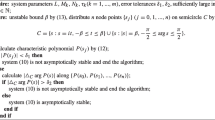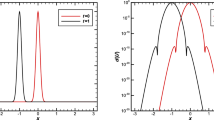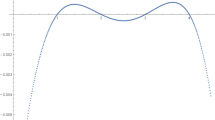Abstract
The hopscotch method is a numerical integration method that can be applied efficiently to the system of ordinary differential equations arising by space-discretization of time dependent partial differential equations (PDEs). The error propagation of this method from one time level to another can be described by a three-term matrix-vector recursion. In regards to PDEs that relate to (multi-dimensional) bending beam equations, we obtain an explicit sharp bound for the discreteL 2-norm of the propagated error. This bound is expressed in quantities determined by spectral properties of the matrices in the recursion. The expression leads to conditions under which the hopscotch method is strongly asymptotically stable: that is, the stability is uniform with respect to the mesh widths in space and time (that correlate and that tend to 0) and to the time level (that tends to ∞). In many applications, our conditions completely describe the situation in which the hopscotch method is strongly asymptotically stable. Previously known stability conditions are more restrictive and do not give complete descriptions.
Zusammenfassung
Die Hopscotch-Methode dient zur effizienten numerischen Integration von Systemen gewöhnlicher Differentialgleichungen, welche als Raumdiskretisierung aus zeitabhängigen partiellen Differentialgleichungen entstehen. Die Fortpflanzung des Integrationsfehlers durch die einzelnen Zeitschichten kann man durch eine dreistufige Rekursion beschreiben. Bei einem bestimmten Typ partieller Differentialgleichungen kann eine explizite und scharfe Schranke für den diskretenL 2-Fehler angegeben werden. Außerdem erhält man Bedingungen für die starke und die asymptotische Stabilität der Methode. Zudem ist das Stabilitätsverhalten gleichmäßig in Bezug auf die Raum- und die Zeitdiskretisierung. Diese neuen Bedingungen beschreiben die Stabilität der Hopscotch-Methode in den meisten Anwendungsfällen. Sie gegen weit über den Anwendungsbereich früherer Stabilitätsbedingungen hinaus.
Similar content being viewed by others
References
Evans, D. J., Danaee, A.: A new group hopscotch method for the numerical solution of partial differential equations. SIAM J. Numer. Anal.19, 588–598 (1982).
Gane, C. R., Gourlay, A. R.: Block hopscotch procedures for second order parabolic differential equations. JIMA19, 205–216 (1977).
Gourlay, A. R.: Hopscotch: A fast second-order partial differential equation solver. JIMA6, 375–390 (1970).
Hundsdorfer, W. H., Verwer, J. G.: Linear stability of the hopscotch scheme. Report NM-R8603, Centre for Math. and Comp. Sc., Amsterdam 1986.
Kato, T.: Perturbation theory for linear operators. Berlin-Heidelberg-New York: Springer 1966.
Kellogg, R. B.: An alternating direction method for operator equations. J. Soc. Ind. Appl. Math.12, 848–853 (1964).
ter Maten, E. J. W.: Stability analysis of finite difference methods for fourth order parabolic equations. Thesis, University of Utrecht 1984.
ter Maten, E. J. W., Sleijpen, G. L. G.: A convergence analysis of hopscotch methods for fourth order parabolic equations. Numerische Mathematik49, 275–290 (1986).
Author information
Authors and Affiliations
Rights and permissions
About this article
Cite this article
Sleijpen, G.L.G. Strong stability results for the hopscotch method with applications to bending beam equations. Computing 41, 179–203 (1989). https://doi.org/10.1007/BF02259092
Received:
Issue Date:
DOI: https://doi.org/10.1007/BF02259092




